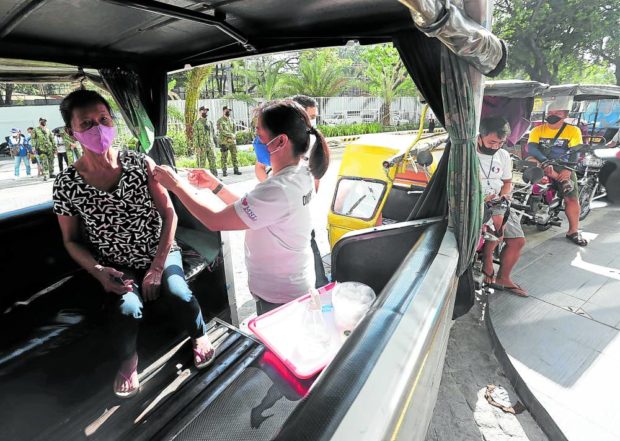NCR may be ‘low risk’ in 2 weeks if downward trend continues — Octa

GETTING PROTECTION People get inoculated at the drive-thru vaccination site at the compound of the newly built Bagong Ospital ng Maynila on Monday. The 10-story, 384-bed capacity hospital, set to open in June, is expected to help ease the load of other medical facilities in Manila amid the pandemic. —MARIANNE BERMUDEZ
MANILA, Philippines — Metro Manila’s COVID-19 classification may further decrease to low risk within two weeks if infections continue to decline, a fellow of the independent analytics group Octa Research said Sunday.
Currently, the National Capital Region (NCR) is at moderate risk, the Department of Health (DOH) recently said.
“NCR could improve to low risk within two weeks if downtrend continues,” Octa fellow Dr. Guido David posted on Twitter.
NCR, Cavite and Rizal at moderate risk based on Covidactnow. Note that positivity rates are still very high at > 20%. Batangas, Laguna Quezon still at high risk. We need to strictly comply with health protocols to bring this down to low risk. @dzbb @allangatus @DZAR1026 @dzrhnews pic.twitter.com/h8tRet9v0t
— Dr. Guido David (@iamguidodavid) January 30, 2022
Based on DOH data, David said that NCR now has a -68 percent growth rate from -69 percent on January 29.
Article continues after this advertisementMeanwhile, the average daily attack rate (ADAR) stood at 23.01 from 31.13 logged last January 27.
Article continues after this advertisementADAR refers to the average number of new COVID-19 cases per 100,000 individuals.
The reproduction number, on the other hand, decreased from 0.50 on January 29 to 0.47.
The healthcare utilization rate is low at 40 percent, David’s report showed.
However, the COVID-19 positivity rate remained “very high” at 20 percent from the previous 21 percent.
Aside from NCR, also at moderate risk are Cavite and Rizal. However, the adjacent provinces’ positivity rates are also “very high.”
“NCR, Cavite and Rizal at moderate risk based on Covidactnow. Note that positivity rates are still very high at > 20%,” David posted on Twitter.
Moreover, Batangas, Laguna, and Quezon are still at high risk, David said.
On Saturday, the Philippines on Saturday reported 17,382 cases — the lowest daily infections since January 6 when 17,220 cases were reported — to bring the caseload to 3,528,796.